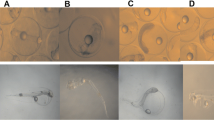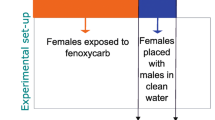Abstract
Grass shrimp (Palaemonetes pugio) were reared separately through both embryonic and total larval development during exposure to fenoxycarb at measured concentrations of <2.2 to 888 μg L−1. A fenoxycarb concentration of 888 μg L−1 significantly (p < 0.05) inhibited embryonic development to larval hatching and extended the embryonic developmental period from 11.9 to 12.7 days. Exposure to fenoxycarb concentrations ≤502 μg L−1 had no significant (p > 0.05) effect on complete embryonic development. Significantly fewer shrimp successfully metamorphosed to postlarvae when exposed through complete larval development to fenoxycarb concentrations ≥4 μg L−1. Larval development of grass shrimp was therefore >2 orders of magnitude more sensitive to this juvenile hormone agonist than was embryonic development. Viability of larvae developing in fenoxycarb was concentration dependent. Development beyond third zoeal stage was significantly inhibited at fenoxycarb concentrations ≥190 μg L−1, whereas development beyond fourth zoeal stage was inhibited by a concentration of ≥45 μg L−1. Fenoxycarb exposure of developing larvae did not alter either the duration of total larval development or the total number of larval stages before metamorphosis. Rearing of fenoxycarb-exposed embryos through larval development without further exposure had no significant effect on number of larval stages, larval development rate, or metamorphic success of larvae. Similarities in the sensitivity of grass shrimp larvae and mosquito larvae to fenoxycarb suggests that the use of a bioassay protocol measuring the metamorphic success of crustacean larvae would be a valuable adjunct to the hazard assessment of newly developed pesticides that target endocrine control of metamorphosis in insects and possibly other endocrine-disrupting xenobiotics as well.
Similar content being viewed by others
Author information
Authors and Affiliations
Rights and permissions
About this article
Cite this article
McKenney, ., Cripe, ., Foss, . et al. Comparative Embryonic and Larval Developmental Responses of Estuarine Shrimp (Palaemonetes pugio) to the Juvenile Hormone Agonist Fenoxycarb. Arch Environ Contam Toxicol 47, 463–470 (2004). https://doi.org/10.1007/s00244-002-0294-4
Issue Date:
DOI: https://doi.org/10.1007/s00244-002-0294-4




